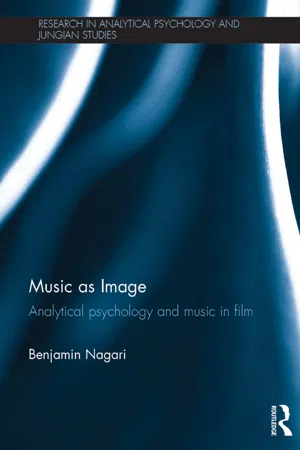
Music as Image
Analytical psychology and music in film
Benjamin Nagari
- 158 pages
- English
- ePUB (adapté aux mobiles)
- Disponible sur iOS et Android
Music as Image
Analytical psychology and music in film
Benjamin Nagari
À propos de ce livre
Through a theoretical and practical exploration of Jungian and post-Jungian concepts surrounding image, this book moves beyond the visual scope of imagery to consider the presence and expression of music and sound, as well as how the psyche encounters expanded images – archetypal, personal or cultural – on both conscious and unconscious levels. By closely examining music in film, Nagari considers music's complementary, enhancing, meaningful, and sometimes disruptive, contribution to expressive images.
Chapters present a Jungian approach to music in film, highlighting how 'music-image' functions both independently and in conjunction with the visual image, and suggesting further directions in areas of research including music therapy and autism. Divided into three cumulative parts, Part I explores the Jungian psychological account of the music-image; Part II combines theory with practice in analysing how the auditory image works with the visual to create the 'film as a whole' experience; and Part III implements a specific understanding of three individual film cases of different genres, eras and styles as psychologically scrutinised 'case histories'.
Music as Image will be of interest to academics and students in the fields of applied psychoanalysis and Jungian psychology, music, film and cultural studies. With implications for music therapy and other art-based therapies, it will also be relevant for practising psychotherapists.
Foire aux questions
Informations
Part I The psychological image
Introduction
I have chosen the term “collective” because this part of the unconscious is not individual but universal; in contrast to the personal psyche, it has contents and modes of behaviour that are more or less the same everywhere and in all individuals. It is, in other words, identical in all men and thus constitutes a common psychic substrate of a suprapersonal nature which is present in every one of us.(Jung, CW 9I, para. 3)
Chapter 1 Jung, image, archetype and complex
When I speak of “image” … I do not mean the psychic reflection of an external object, but a concept derived from poetic usage, namely, a figure of fancy or fantasy-image, which is related only indirectly to the perception of an external object. This image depends much more on unconscious fantasy activity, and as the product of such activity it appears more or less abruptly in consciousness, somewhat in the manner of a vision or hallucination, but without possessing the morbid traits that are found in a clinical picture.(Jung, CW 6, para. 743)
Although, as a rule, no reality-value attaches to the image, this can at times actually increase its importance for psychic life, since it then has a greater psychological value, representing an inner reality which often far outweighs the importance of external reality. In this case the orientation (q.v.) of the individual is concerned less with adaptation to reality than with adaptation to inner demands.(Jung, CW 6, para. 744)
Table des matières
- Cover Page
- Half Title Page
- Title Page
- Copyright Page
- Dedication
- Table of Contents
- Acknowledgements
- Introduction
- Part I The psychological image: imaging and imagination - a Jungian perspective
- Part II Music as image: the encounter of visual and nonvisual in film
- Part III Close encounters of the musical kind: an analysis of the music-image in three films
- Finale (Conclusion)
- Bibliography
- Filmography
- Index